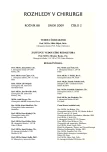Radiographic Evaluation of Scapula Fractures
Authors:
J. Bartoníček; M. Tuček; V. Frič
Authors‘ workplace:
Ortopedicko-traumatologická klinika 3. LF UK a FNKV, Praha-Vinohrady
přednosta: prof. MUDr. Jan Bartoníček, DrSc.
Published in:
Rozhl. Chir., 2009, roč. 88, č. 2, s. 84-88.
Category:
Monothematic special - Original
Overview
The authors use both radiographic and CT examination for diagnosing fractures of the scapula. The standard trauma series consists of chest radiograph, ap radiograph of injured shoulder girdle, ap and lateral radiographs of the scapula (Neer I and II views). According to our experience, the axillary view is not very helpful.
Chest radiograph allows for assessment of the thoracic wall, lungs and of both of the shoulder girdles, particularly the position of both scapulas with regard to the spine (thoracoscapular dissociation). The radiograph of the shoulder girdle should cover the entire scapula, the clavicle, acromioclavicular and sternoclavicular joints, and the proximal humerus. Where a scapula fracture is found, Neer I and II views are used. Neer I view is used to evaluate the joint line of the glenohumeral joint, medial displacement of the glenoid and to determine the value of the glenopolar angle. Neer II view, also called Y-view, allows assessing translation, angulation and overlapping of fragments of the lateral borders of the scapular body.
CT scans are helpful for evaluation of the glenoid fossa and, where necessary, of the processes of the scapula. They, however, do not allow for correct determining of the fracture types, those of the scapular body in particular. Three-dimensional CT reconstruction is the only method that is able to determine the personality of the scapula fracture. In these reconstructions it is necessary to image the scapula from the anterior, posterior, medial and lateral aspects. Evaluation of the glenoid fossa and of the adjacent parts of the lateral border of the scapula requires subtraction of the proximal humerus and the clavicle.
The authors verified the contribution of this radiodiagnostic method on a group of 25 patients with a fracture of the scapula, operated on between 2005 and 2008.
Key words:
scapula – scapula fractures – radiodiagnostics
Sources
1. Ada, J. R., Miller, M. E. Scapula fractures. Analysis of 113 cases. Clin. Ortop., 1991, 269, 174–180.
2. Armstrong, C. P., van der Spuy, J. The fractures scapula: Importance and management based on series of 62 patients. Injury, 1984, 15, 324–329.
3. Bartoníček, J. Tuček, M. Luňáček, L. Judetův zadní přístup k lopatce. Acta Chir. Orthop. Tramatol. Čechoslov., 2008, 75, 429–435.
4. Bozkurt, M., Can, F., Kirdemir, V., Erden, Z., Demirkale, I., Bosbozkurt, M. Conservative treatment of scapula neck fracture: the effect of stability and glenopolar angle on clinical outcome. Injury, 2006, 36, 1176–1181.
5. Cole, P. A. Scapula fractures. Orthop. Clin. N. Amer., 2002, 33, 1–18.
6. Cole, P. A. Scapula fractures: Open reduction internal fixation. In: Wiss, D. A. (ed): Master techniques in orthopaedic surgery. Philadelphia, Lippincot, Williams and Wilkins, 2006, 15–36.
7. Cole, P. A., Marek, D. J. Shoulder girdle injuries. In: Standard, J. P., Schmidt, A. H., Gregor, P. J. (eds): Surgical treatment of orthopaedic trauma. New York, Stuttgart, Thieme, 2007, 207–237.
8. Heim, K. A., Lantry, J. M., Burke, C. S., Roberts, C. S. Early results of scapular fractures treated operatively at a level one trauma center. Europ. J. Trauma, 2008, 34, 55–59.
9. Hersovici, D., Roberts, C. S. Scapula fractures: to fix or not to fix? J. Orthop. Trauma, 2006, 20, 227–299.
10. Jeong, G. K., Zuckerman, J. D. Scapula fractures. In: Zuckerman, J. D., Koval, K. J. (eds). Shoulder fractures. New York, Thieme, 2005, 199–222.
11. Lange, R. H., Noel, S. H. Traumatic lateral scapular displacement: And expanded spectrum of associated neurovascular injury. J. Orthop. Trauma, 1993, 7, 361–366.
12. Lantry, J. M., Roberts, C. S., Giannoudis, P. V. Operative treatment of scapular fractures: A systematic review. Injury, 2008, 39, 271–283.
13. Lapner, P. C., Uhthoff, H. K., Papp, S. Scapula fractures. Clin. Orthop. N. Amer., 2008, 39, 459–474.
14. Mc Adams, T. R., Blevins, F. T., Martin, T. P., Decoster, T. A. The role of plain films and computed tomography in the evaluation of scapula neck fractures. J. Orthop. Trauma, 2002, 16, 7–11.
15. Nau, T., Petras, N., Vécsei, V. Fractures of the scapula – classification and treatment principles. Osteo Trauma Care, 2004, 12, 174–179.
16. Nordqvist, A., Petersson, C. Fractures of the body, neck, or spine of the scapula. Clin. Orthop., 1992, 283, 139–144.
17. Pace, A. M., Stuart, R., Brownlow, H. Outcome of glenoid neck fractures. J. Shoulder Elbow Surg., 2005, 14, 585–590.
18. Romero, J., Schai, O., Imhoff, A. B. Scapula neck fracture: the influence of permanent malalignment of the glenoid neck on clinical outcome. Arch. Orthop. Trauma Surg., 2001, 212, 313–316.
19. Tadros, A. M. A., Lunsjo, K., Czechowski, J., Abu-Zidan, F. M. Multiple-region scapula fractures had more severe chest injury than single-region fractures: A prospective study of 107 blunt trauma patients. J. Trauma, 63, 889–893.
20. Tadros, A. M. A., Lunsjo, K., Czechowski, J., Abu-Zidan, F. M. Causes of delayed diagnosis of scapular fractures. Injury, 2008, 39, 314–318.
21. Thompson, D. A., Flynn, T. C., Miller, P. W., Fischer, R. P. The significance of scapular fractures. J. Trauma, 1985, 25, 974–977.
22. Tscherne, H., Christ, M. Konservative und operative Therapie der Schulterblattbrüche. H Unfallheilkunde, 1975, 126, 52–57.
23. Wiedemann, E. Frakturen der Scapula. Unfallchirurgie, 2004, 107, 1124–1133.
24. Zlowodski, M., Bhandari, M., Zelle, B. A., Kregor, Cole, P. A. Treatment of scapula fractures: systematic review of 520 fractures in 22 case series. J. Orthop. Trauma, 2006, 20, 230–233.
Labels
Surgery Orthopaedics Trauma surgeryArticle was published in
Perspectives in Surgery

2009 Issue 2
Most read in this issue
- Radiographic Evaluation of Scapula Fractures
- Traumatic Perforation of the Duodenum – A Case Review
- A Double Penetration Wound of the Thoracic Wall in an Afghan Military Policeman
- Ischemia-reperfusion Injury in Kidney Transplantation from Non-heart Beating Donor – Do Antioxidants or Antiinflammatory Drugs Play Any Role?
